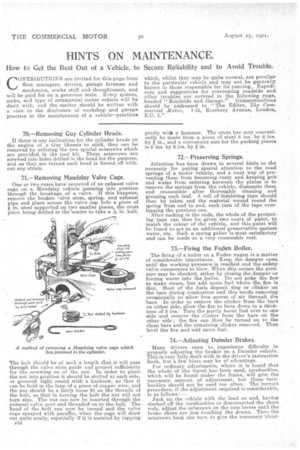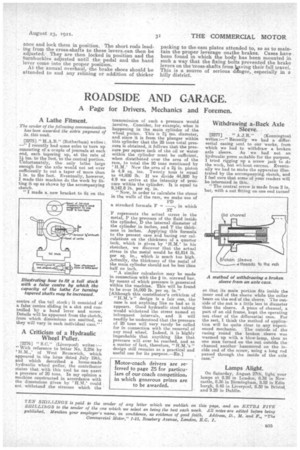HINTS ON MAINTENANCE.
Page 30

Page 31

If you've noticed an error in this article please click here to report it so we can fix it.
How to Get the Best Out of a Vehicle, to Secure Reliability and to Avoid Trouble.
CONTRIBUTIONS are invited for this page from fleet managers, drivers, garage foremen and mechanics, works staff and draughtsmen, and will be paid for on a generous scale. Every system, make, and type of commercial motor vehicle will be dealt with, and the matter should be written with a view to the disclosure of workshop and garage practice in the maintenance of a vehicle—practices which, whilst they may be quite normal, are peculiar to the particular vehicle and may not be generally known to those responsible for its running. Expedients and suggestions for overcoming roadside and other troubles are covered in the following page, headed "Roadside and Garage." Communications should be addressed to "The Editor, The Commercial Motor, 7-15, Rosebery Avenue, London, RC. 1."
70.—Removing Guy Cylinder Heads.
If there is any inclination for the cylinder heads on the engine of a Guy ichassia to stick, they can be removed by utilizing the two special setscrews which are provided in the tool kit. These setscrews are screwed into holes drilled in the head for the purpose, and as they are turned each head is forced off without any strain.
71.— Removing Maudslay Valve Cage.
One or two cases have occurred of an exhaust valve cage on a Maudslay vehicle jamming into position through the breakage of a valve. If this happens, remove the broken salve stem, spring, and exhaust pipe and place across, the valve cap hole a piece of t in. steel supported on two smaller pieces the cross piece being drilled in the 'centre to take a -;zs in. bolt.
The bolt should be of such a length that it will pass through the valve stem guide and project sufficiently for the screwing on of the nut. In order to place the nut into position it should be slotted at each side, or grooved right round with a hacksaw, so that it can be held in the loop of a piece of copper wire, and the nut should be a fairly loose fit on the threads of the bolt., so that in turning the bolt the nut will not turn also. The nut can now be inserted through the exhaust valve port and threaded on to the bolt. The head of the bolt can now be turned and the valve cage sprayed with paraffin, when the cage will draw out quite easily, especially if it is assisted by tapping
B34
gently with a hammer. The cross bar may conveniently be made from a piece of steel 5 ins. by 2 ins. by in., and a convenient size for the packing pieces is 2 ins. by 2 ins, by in.
72.—Preserving Springs.
Attention has been drawn in several hints to the necessity for paying special attention to the road springs of a, motor vehicle, and a neat way of preventing these from becoming rusty and keeping grit and water from entering between the plates is to remove the springs from the vehicle, dismantle them and reassemble after thoroughly cleaning and greasing each leaf. A roll of insulating tape should then be taken and the material wound round the spring from end to end, each turn of the tape overlapping the previous one.
After tucking in the ends, the whole of the protecting tape can then be given two coats of paint, to match the colour of the vehicle, and this paint will be found to act as an additional Rreservative against water, etc. Such a spring gaiter is most satisfactory and can be made at a very reasonable cost.
73.—Firing the Foden Boiler.
The firing of a boiler on a Foden wagon is a matter of considerable importance. Keep the damper open until the working pressure is reached and the safety valve commences to blow. When this occurs the pressure may be checked, either by closing the damper or forcing water into the boiler. Do not poke the fireto make steam, (but add some fuel where the fire is thin. Most of the fuels deposit slag OT clinker on the bars during combustion and this needs removing occasionally to allow free access of air through the bars. In order Co remove the clinkerfrom the bars on either side, allow the fire to burn down to a thickness of 3 ins. Turn the partly burnt fuel over to one side 'and, remove the clinker from the bars on. the other side; the fire can then he turned on to the clean bars and the remaining ()linker removed. Then level the fire and -add more fuel.
74.—Adjusting Daimler Brakes.
Many drivers seem to experience difficulty in properly adjusting the brakes on a Daimler vehicle. This is very fully dealt with in the driver's instruction book, but a few hints may be of advantage.
For ordinary adjustments, where it is found that the whole of the travel has been used, turnbuckles, which will be found under the frame, will give the necessary amount of adjustment. but these turnbuckles should not be used too often. The 'correct procedure, if the adjustment required is considerable, is as follows :— hick up the vehicle with the load on and, having slacked off the turnbuckles or disconnected the short rods adjust the setscrews on the cam levers until the brake shoes are just touching the drums. Turn the setscrews back one turn to give the necessary 'clear ance and lock them in position. The short rods leading from the cross-shafts to these levers.can then be adjusted. They are then locked in position and the turnbuckles adjusted until the pedal and the band lever come into the proper position. At the annual overhaul, the brake shoes should be attended to and any relining or addition of thicker
packing to the,cam plates attended to, so as to maintain the proper leverage onsthe brakes. Cases have been found in which the body has been mounted in such a way that the fixing bolts prevented the brake levers on the "cross-shafts from laving their full travel. This is a source of serious ddnger,. especially in a hilly district.
































